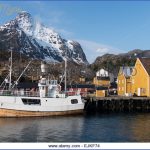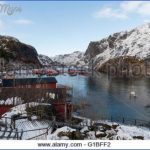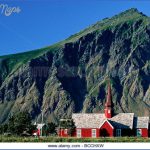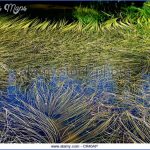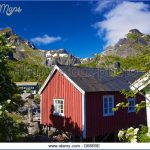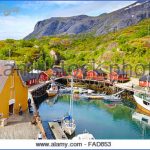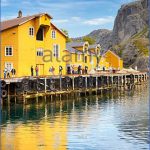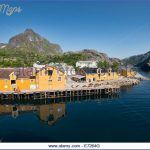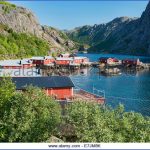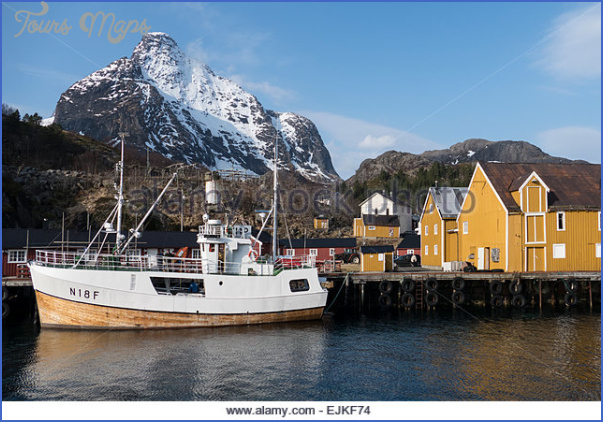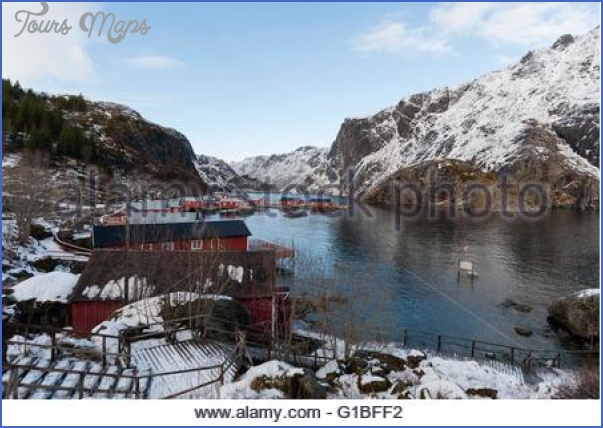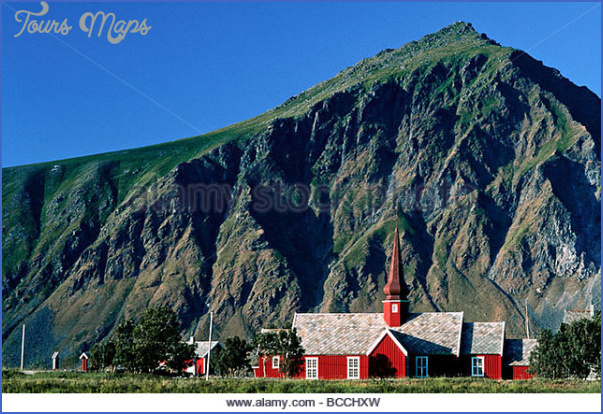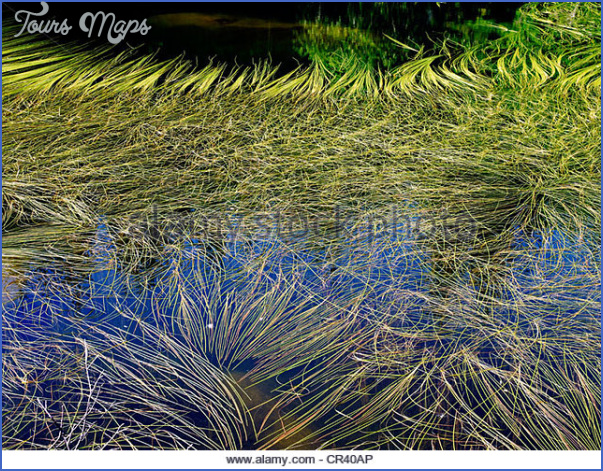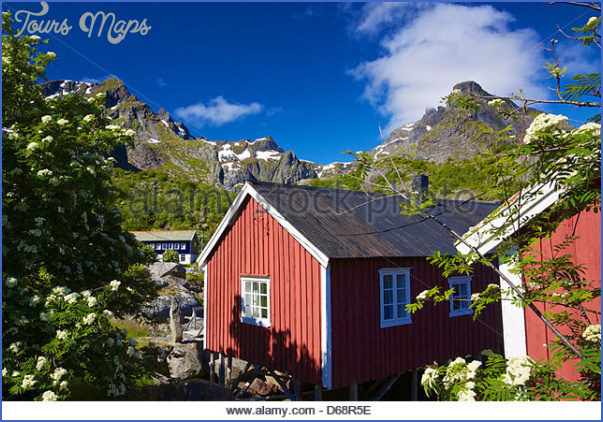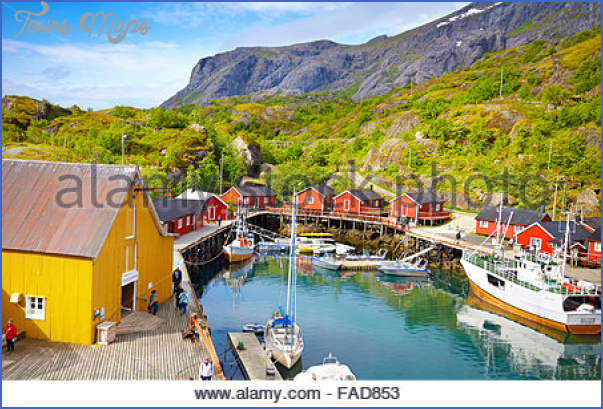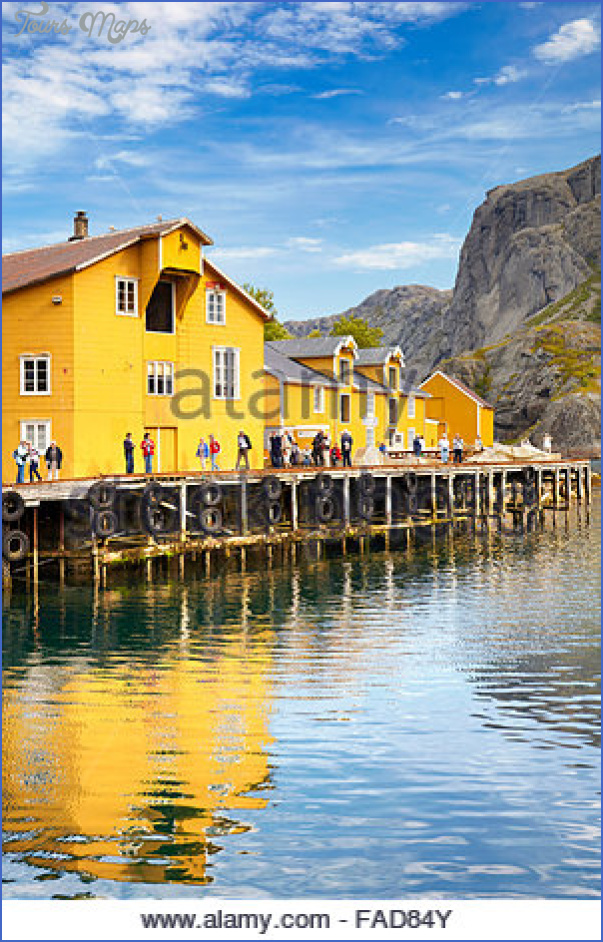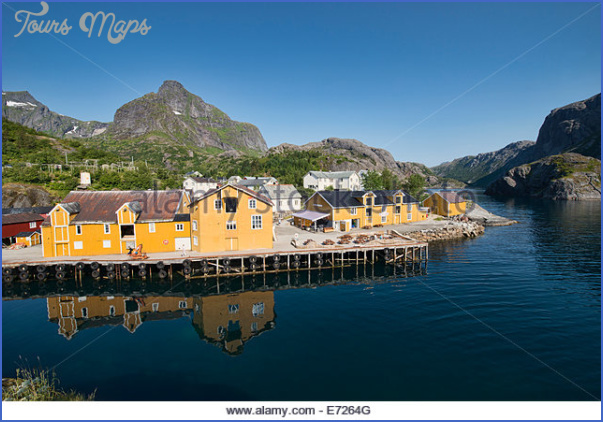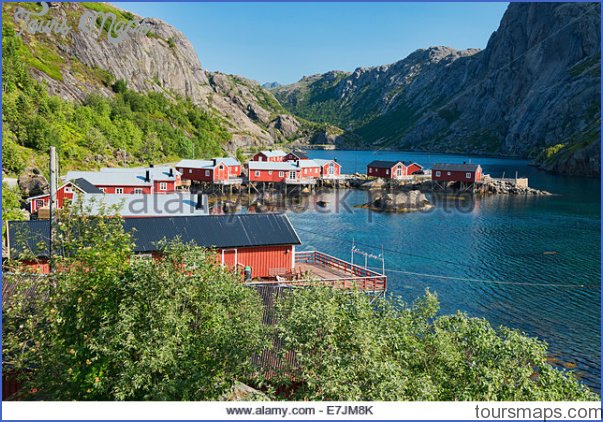The season for the Lofoten fisheries, for which thousands of fishermen gather with their boats, is from mid-January to mid-April. The main catch is cod (Norwegian torsk). From the beginning of January the cod, predatory fish which normally live deep in the Atlantic, head for the coast in long shoals several yards deep to spawn. The depth at which they swim varies according to the temperature ofthe water, ranging between 100 m (328 ft) and 300 m (985 ft). Once landed, the cod are the head and entrails removed. They are then either hung on timber racks (hjeller) to dry, remaining on the racks until June (terrfisk, stockfish); or they are salted and laid out on the rocks (klippfisk), and then piled in heaps, which are covered to protect them from moisture. Some of the fish are not dried but are salted in barrels (laberdan). The heads are processed in guano factories to produce fertilisers, the roe tinned, and the livers used in the manufacture of cod liver oil. After the winter fishing season, most of the fishermen head N to Finnmark and the summer fisheries in coastal waters.
Kunstnernes Hus (Artists’ House), which displays works by the many painters who have found inspiration in the Lofotens. Opposite the wharf on the little island of Gunnarholm (road bridge from Svolvaer) is the grave of the Nordland painter Gunnar Berg (b. Svolvaer 1864, d. in Berlin 1 894). From the steep-sided hill to the N, Blatind (597 m (1959 ft): 5 hours round trip for fit walkers), there are magnificent views; midnight sun from the end of May to mid-July. An attractive trip is by motorboat (2 hours) tothe S end of the island of Hinney, in the VesterSI group ( 291), where Digermulkol-lert offers a rewarding climb (1J hours). The boat also sails through the southern part of the ~Raftsund (8 km (5 miles) long), between the Lofotens and the Vesterfll islands. On the W side of the Raftsund a narrow rocky opening gives access to the Trollfjord. Behind the Trollfjord the snow-covered Higravtinder (1161 m 3908 ft) and the jagged Trolltinder (1 045 m 3429 ft) rise above the Trollfjordvatn, a mountain lake 3 km (2 miles) long (almost always frozen). The most populardaytriptotheTrollfjord is by bus from Svolvaer via Fiskebol to Stokmarknes and back by the Hurtig-rute boat, which sails via the Trollfjord. 1 0 km (6 miles) SW of Svolvaer (bus) is the village of Kabelvig (Hospits, 12 several camp sites), with a Fisheries Museum, the Lofoten Aquarium (fish and other marine fauna from the Vestfjord) and V3gan church, the largest wooden church N of Trondheim.
At the SW tip of Austvcigoy, under Vagekalle (942 m (3091 ft); 3 hours’ climb), is Festvag. A ferry crosses in 12 minutes to the typical little fishing settlement of Henningsvaer, on a group of small islands; a large fishing fleet gathers there in winter.
On the SE coast of the large island of VestvSgoy is Stamsund (SAS Lofoten Hotell, 55 SP; Havly Hospits, 12 youth hostel), one of the largest of the little fishing towns in the archipelago and the hub of communications in the western Lofotens. At the S W end of VestvSgoy is the fishing village of Ballstad, at the foot of Ballstadaksla (466 m 1 529 ft).
On the NW coast of the island of Flakstadoy lies Ramberg (Gjestgiveri, 16 10 chalets), administrative headquarters of the island. To the E of the village stands the church (1780), originally built of driftwood.
The chief place on the island of Mosken-esoy is the fishing village of Reine (Havly Hospits, 11 b.) on the Kirkefjord, a resort popular with painters and climbers. 1 0 km (6 miles) SW is the little settlement of A, at the end of the Lofoten road. From the higher ground above the village, there is a view of the Moskenesstraum, a whirlpool between the cape of Lofotodde and the island of Moskenesoy. It was described by Jules Verne and Edgar Allan Poe as the Maelstrom.
From Reine there are boat trips to the little island of Vaeroy, to the SW. At the S end ofthis island is the Mostadfjell, rearing steeply above the abandoned village of Mostad. These heights are a paradise for birds; more than a million birds primarily puffins, but also guillemots, cormorants and white-tailed eagles breed between May and August. The nesting sites can be reached by renting a boat from the village of Vaeroy (20 minutes). On Vaeroy are the last specimens of a curious breed of dog with six toes, known as a puffin hound since it is used for catching these birds.
There are also boat trips from Reine (5 hours), as well as from Bodo (5 hours) and Vaeroy (2i hours), to the remarkable Rost islands, almost 100 km (65 miles) from the mainland (Havly Hospits, 22 b.), with a series of high crags (Vedoy,
Storfjell, Stavoy, the Nykan rocks) inhabited by one of the largest assemblages of seabirds in the world, including some 3 million puffins, as well as rare species like storm petrels and fulmars. The crags can be reached by boat from Rostland; during the season there are also helicopter flights from Bodo.
The Nusfjord on the island of Flakstadoy Lofotens Photo Gallery
Maybe You Like Them Too
- The Best Cities To Visit in The World
- World’s 10 Best Places To Visit
- Coolest Countries in the World to Visit
- Travel to Santorini, Greece
- Map of Barbados – Holiday in Barbados

